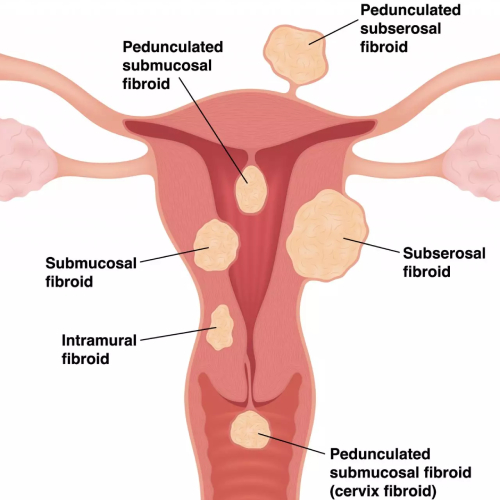What is Myoma? Diagnosis and Treatment Methods
What is myoma? Uterine lumps (fibroids) are benign (benign, non-cancerous) growths in the uterus. It is the most common type of enlargement in the female pelvis (in the pelvis, pelvis area, groin).

What is myoma? How is Diagnosis and Treatment Made?
It is found in approximately 25-50% of all women. Many women with fibroids are unaware of this because these bumps may remain small and cause no symptoms or problems. However, in some women, fibroids can cause problems due to their size, number and location. Like all abnormal growths, fibroids should be examined by a doctor. this section
- Types of fibroids
- Symptoms
- It provides information about diagnosis and treatment.
Types of Myoma
Fibroids are benign growths that are quite common in women. About one in four or five women over the age of 35 have them. Uterine tubercles are growths that develop from the cells that make up the muscle layer of the uterus.
The size, shape and location of fibroids can vary greatly. They can be seen on the wall or outer surface of the uterus.
Fibroids vary in size. It can be as small as a pea, or it can reach sizes to fill the whole stomach. As it grows, it can damage the inside of the uterus as well as the outside.
A woman can have only a single fibroid or multiple different sizes. It is difficult to predict whether fibroids will occur singly or in groups. They can stay very small for a long time, grow rapidly, or grow slowly over years.
Reasons
Fibroids are most common in women aged 30-40, but they can occur at any age. Although fibroids are quite common, little is known about what causes them. The female hormone estrogen seems to increase their growth. Estrogen levels in the body can increase or decrease depending on natural events. For example, pregnancy causes an increase in estrogen, while menopause causes a decrease. Medications can also cause changes in estrogen levels.
Symptoms
Most fibroids, even large ones, do not give any symptoms. If symptoms do occur, they are often:
Changes in menstruation
- More bleeding
- Longer or more frequent menstrual periods
- Menstrual pain (cramps)
- Vaginal bleeding during non-menstrual times
- Anemia (due to blood loss)
Pain
- Abdomen or lower back (often blunt, heavy and aching, but can be sharp)
- During intercourse
Oppression
- Difficulty urinating or frequent urination Constipation, pain in the anus or difficulty in bowel movements
Growth in the uterus and abdomen
Miscarriages and Infertility
These symptoms may also be signs of other problems. That's why you should see your doctor in case of any symptoms.
Diagnosis
The first signs of fibroids can be detected during a routine gynecological examination. There are a number of reviews that can provide more information about fibroids:
- Ultrasonography uses sound waves to create a picture of the uterus or pelvic organs.
- Saline infusion sonography (SIS) is the examination of the uterus accompanied by ultrasonography by injecting saline into the uterus. In this way, fibroids or polyps in the uterus can be differentiated.
- Hysteroscopy uses a thin instrument (hysteroscope) to help the doctor see inside the uterus. It is inserted through the vagina and cervix (cervix). This allows the doctor to see some fibroids in the uterine cavity.
- Hysterosalpingography (HSG) is a special x-ray film. It can detect abnormal changes in the shape and size of the uterus and tubes.
- Laparoscopy uses a thin instrument (laparoscope) to help the doctor see inside the abdomen. It is inserted through a small incision made in the navel or just below. The doctor can see the fibroids on the outer surface of the uterus with the laparoscope.
Imaging studies, such as magnetic resonance imaging (MRI) and computed tomography (CT), may be used but are rarely required. Sometimes, fibroids can be detected incidentally when these tests or other procedures are used to examine another medical problem or symptoms.
Problems
Although most fibroids do not cause problems, complications may rarely develop. Myomas, which are connected to the uterus by a stem, can rotate around the stem. This can cause pain, nausea or fever. Fibroids can become infected (inflamed). In many cases this only happens if there is already an infection in that area. In very rare cases, rapid growth of myoma and other symptoms may indicate cancer.
A very large fibroid can cause the abdomen to swell. This can make it difficult to do a full gynecological exam.
Fibroids can also cause infertility. This is rare and other factors should be investigated before fibroids can be considered the cause of a couple's infertility.
Treatment
Fibroids that do not cause symptoms, are small, or appear in a woman approaching menopause often do not require treatment. However, certain complaints and symptoms may indicate the need for treatment:
- Heavy or painful menstrual periods
- Bleeding between periods
- Failure to differentiate from another tumor such as fibroid or ovarian tumor
- Rapid increase in fibroid growth
- Infertility
- Groin pain
If you have fibroids or have had them in the past, be sure to have regular checkups. If you have symptoms of fibroids, see your doctor right away. Unless fibroids cause pain during intercourse, there is no need to restrict your sexual activity.
Fibroids can be treated with medication or surgery. Medications, such as gonadotropin-releasing hormone (GnRH) agonists, can be used to temporarily shrink fibroids in preparation for surgery and to control bleeding. The choice of treatment depends on factors such as your own wishes and your doctor's medical recommendations about the size and location of the fibroids.
You can visit our Youtube page to get fast and accurate information on genital infections, IVF, gynecological diseases, drug use trainings, and many more.
Gynecology, In Vitro Fertilization pages.

